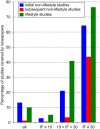Poor replication validity of biomedical association studies reported by newspapers
- PMID: 28222122
- PMCID: PMC5319681
- DOI: 10.1371/journal.pone.0172650
Poor replication validity of biomedical association studies reported by newspapers
Abstract
Objective: To investigate the replication validity of biomedical association studies covered by newspapers.
Methods: We used a database of 4723 primary studies included in 306 meta-analysis articles. These studies associated a risk factor with a disease in three biomedical domains, psychiatry, neurology and four somatic diseases. They were classified into a lifestyle category (e.g. smoking) and a non-lifestyle category (e.g. genetic risk). Using the database Dow Jones Factiva, we investigated the newspaper coverage of each study. Their replication validity was assessed using a comparison with their corresponding meta-analyses.
Results: Among the 5029 articles of our database, 156 primary studies (of which 63 were lifestyle studies) and 5 meta-analysis articles were reported in 1561 newspaper articles. The percentage of covered studies and the number of newspaper articles per study strongly increased with the impact factor of the journal that published each scientific study. Newspapers almost equally covered initial (5/39 12.8%) and subsequent (58/600 9.7%) lifestyle studies. In contrast, initial non-lifestyle studies were covered more often (48/366 13.1%) than subsequent ones (45/3718 1.2%). Newspapers never covered initial studies reporting null findings and rarely reported subsequent null observations. Only 48.7% of the 156 studies reported by newspapers were confirmed by the corresponding meta-analyses. Initial non-lifestyle studies were less often confirmed (16/48) than subsequent ones (29/45) and than lifestyle studies (31/63). Psychiatric studies covered by newspapers were less often confirmed (10/38) than the neurological (26/41) or somatic (40/77) ones. This is correlated to an even larger coverage of initial studies in psychiatry. Whereas 234 newspaper articles covered the 35 initial studies that were later disconfirmed, only four press articles covered a subsequent null finding and mentioned the refutation of an initial claim.
Conclusion: Journalists preferentially cover initial findings although they are often contradicted by meta-analyses and rarely inform the public when they are disconfirmed.
Conflict of interest statement
Figures



References
MeSH terms
LinkOut - more resources
Full Text Sources
Other Literature Sources

